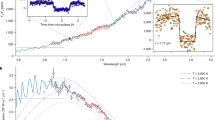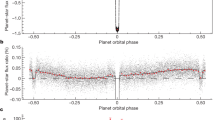Abstract
Recent observations of the extrasolar planet HD 189733b did not reveal the presence of water in the emission spectrum of the planet1. Yet models of such ‘hot-Jupiter’ planets predict an abundance of atmospheric water vapour2. Validating and constraining these models is crucial to understanding the physics and chemistry of planetary atmospheres in extreme environments. Indications of the presence of water in the atmosphere of HD 189733b have recently been found in transmission spectra3,4, where the planet’s atmosphere selectively absorbs the light of the parent star, and in broadband photometry5. Here we report the detection of strong water absorption in a high-signal-to-noise, mid-infrared emission spectrum of the planet itself. We find both a strong downturn in the flux ratio below 10 µm and discrete spectral features that are characteristic of strong absorption by water vapour. The differences between these and previous observations are significant and admit the possibility that predicted planetary-scale dynamical weather structures6 may alter the emission spectrum over time. Models that match the observed spectrum and the broadband photometry suggest that heat redistribution from the dayside to the nightside is weak. Reconciling this with the high nightside temperature7 will require a better understanding of atmospheric circulation or possible additional energy sources.
This is a preview of subscription content, access via your institution
Access options
Subscribe to this journal
Receive 51 print issues and online access
$199.00 per year
only $3.90 per issue
Buy this article
- Purchase on Springer Link
- Instant access to full article PDF
Prices may be subject to local taxes which are calculated during checkout

Similar content being viewed by others
References
Grillmair, C. J. et al. A Spitzer spectrum of the extrasolar planet HD 189733b. Astrophys. J. 685, L115–L118 (2007)
Burrows, A. A theoretical look at the direct detection of giant planets outside the solar system. Nature 433, 261–268 (2005)
Swain, M. E., Vasisht, G. & Tinetti, G. Methane present in an extrasolar planet atmosphere. Nature 452, 329–331 (2008)
Tinetti, G. et al. Water vapour in the atmosphere of a transiting extrasolar planet. Nature 448, 169–171 (2007)
Charbonneau, D. et al. The broadband infrared emission spectrum of the exoplanet HD 189733b. Astrophys. J. 686, 1341–1348 (2008)
Rauscher, E. et al. On signatures of atmospheric features in thermal phase curves of hot Jupiters. Astrophys. J. 681, 1646–1652 (2008)
Knutson, H. et al. A map of the day-night contrast of the extrasolar planet HD 189733b. Nature 447, 183–186 (2007)
Bouchy, F. et al. ELODIE metallicity-biased search for transiting hot Jupiters. II. A very hot Jupiter transiting the bright K star HD 189733. Astron. Astrophys. 444, L15–L19 (2005)
Charbonneau, D., Brown, T. M., Burrows, A. & Laughlin, G. in Protostars and Planets V (eds Reipurth, B., Jewitt, D. & Keil, K.) 701–716 (Univ. Arizona Press, 2007)
Torres, G., Winn, J. N. & Holman, M. J. Improved parameters for extrasolar transiting planets. Astrophys. J. 677, 1324–1342 (2008)
Ehrenreich, D. et al. A Spitzer search for water in the transiting exoplanet HD 189733b. Astrophys. J. 668, L179–L182 (2007)
Pont, F., Knutson, H., Gilliland, R. L., Moutou, C. & Charbonneau, D. Detection of atmospheric haze on an extrasolar planet : the 0.55–1.05 µm transmission spectrum of HD 189733b with the Hubble Space Telescope. Mon. Not. R. Astron. Soc. 385, 109–118 (2008)
Barman, T. On the presence of water and and global circulation in the transiting planet HD 189733b. Astrophys. J. 676, L61–L64 (2008)
Houck, J. R. et al. The Infrared Spectrograph (IRS) on the Spitzer Space Telescope. Astrophys. J. Suppl. Ser. 154, 18–24 (2004)
Deming, D. et al. Strong infrared emission from the extrasolar planet HD 189733b. Astrophys. J. 644, 560–564 (2006)
Barnes, J. R. et al. Limits on the 2.2μm contrast ratio of the close-orbiting planet HD 189733b. Mon. Not. R. Astron. Soc. 382, 473–480 (2007)
Burrows, A., Budaj, J. & Hubeny, I. Theoretical spectra and light curves of close-in extrasolar giant planets and comparison with data. Astrophys. J. 678, 1436–1457 (2008)
Burrows, A., Sudarsky, D. & Hubeny, I. Theory for the secondary eclipse fluxes, spectra, atmospheres, and light curves of transiting extrasolar giant planets. Astrophys. J. 650, 1140–1149 (2006)
Burrows, A., Hubeny, I. & Sudarsky, D. A theoretical interpretation of the measurements of the secondary eclipses of TrES-1 and HD 209458b. Astrophys. J. 625, L135–L138 (2005)
Knutson, H. A., Charbonneau, D., Allen, L. E., Burrows, A. & Megeath, S. T. The 3.6–8.0 micron broadband spectrum of HD 209458b: Evidence for an atmospheric inversion. Astrophys. J. 673, 526–531 (2008)
Burrows, A., Hubeny, I., Budaj, J., Knutson, H. A. & Charbonneau, D. Theoretical spectral models of the planet HD 209458b with a thermal inversion and water emission bands. Astrophys. J. 668, L171–L174 (2007)
Showman, A. P. et al. Atmospheric circulation of hot Jupiters: Coupled radiative-dynamical general circulation model simulations of HD 189733b and HD 209458b. Astrophys. J. (submitted)
Richardson, L. J. et al. A spectrum of an extrasolar planet. Nature 445, 892–895 (2007)
Swain, M. R. et al. The mid-infrared spectrum of the transiting exoplanet HD 209458b. Astrophys. J. 674, 482–497 (2008)
Fortney, J. J. & Marley, M. S. Analysis of Spitzer spectra of irradiated planets: Evidence for water vapor? Astrophys. J. 666, L45–L48 (2008)
Acknowledgements
This work is based on observations made with the Spitzer Space Telescope, which is operated by the Jet Propulsion Laboratory (JPL), California Institute of Technology (Caltech), under a contract with NASA. Support for this work was provided by NASA through an award issued by JPL/Caltech. This study was supported in part by NASA (grant NNGO4GL22G).
Author information
Authors and Affiliations
Corresponding author
PowerPoint slides
Rights and permissions
About this article
Cite this article
Grillmair, C., Burrows, A., Charbonneau, D. et al. Strong water absorption in the dayside emission spectrum of the planet HD 189733b. Nature 456, 767–769 (2008). https://doi.org/10.1038/nature07574
Received:
Accepted:
Issue Date:
DOI: https://doi.org/10.1038/nature07574
This article is cited by
-
ExoSim: the Exoplanet Observation Simulator
Experimental Astronomy (2021)
-
Water vapour in the atmosphere of the habitable-zone eight-Earth-mass planet K2-18 b
Nature Astronomy (2019)
Comments
By submitting a comment you agree to abide by our Terms and Community Guidelines. If you find something abusive or that does not comply with our terms or guidelines please flag it as inappropriate.



